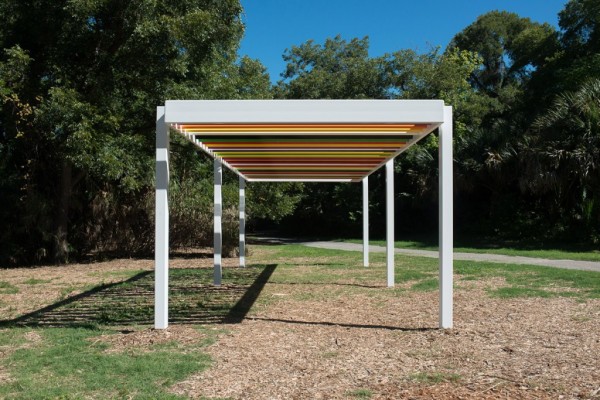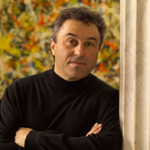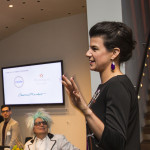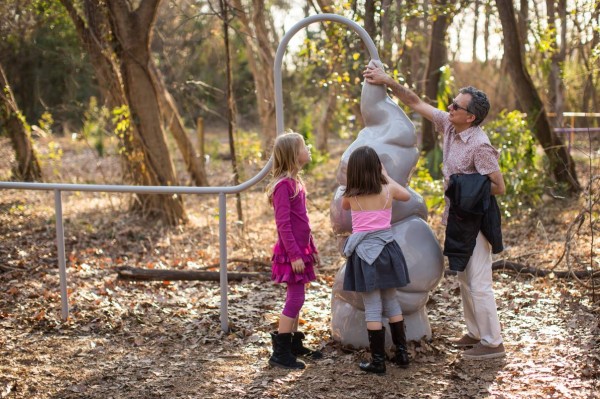It’s been just over a year since Louis Grachos took the helm of AMOA-Arthouse as Executive Director. Within a month of his hire, Heather Pesanti followed Grachos from the Albright-Knox Art Gallery to work in Austin as Senior Curator. Since their arrival, AMOA-Arthouse has revamped their program and mission under a new name, The Contemporary. Before the opening shenanigans for the second show in the rebranded institution, I sat down with Grachos and Pesanti for a series of conversations on their vision for The Contemporary and their adjustment to living and working in Austin. While the main ideas that convinced The Contemporary’s board to hire Grachos are in essence the same since his arrival, both Louis and Heather were extremely generous in elaborating their views on the role of The Contemporary in the city, as well as models and ideas that have been driving their work. Our long conversations have been edited for publication.

Liam Gillick, Raised Laguna Discussion Platform (Job #1073), 2013. Painted steel
1. Some Notes on the Meaning of “Contemporary.”
Dorota Biczel: I wanted to start with the question about the new name of the institution, The Contemporary. I found it somewhat ironic that the first artist to show in the rebranded AMOA-Arthouse was Liam Gillick. A few years ago, he published an essay, a tirade really, against the notion of contemporary art, objecting to it as a too flexible, overgeneralizing, over-inclusive category that levels everything down. So, what does the contemporary mean to you?

Louis Grachos
Louis Grachos: For me, it’s really the way to channel our energies into presenting the kind of a program I feel didn’t exist in Austin. The institutions like the Blanton Museum and Harry Ransom Center have immense opportunities to build collections and scholarship. We have the opportunity to bring artists that have reputation and a broader dialogue around their work globally. The question is how you make their work fresh, new, and relatable for this community, and the way to do it is through commissioning new projects. Commissions are opportunities for artists to stretch and to help us figure out what we’re doing with our two sites and how we operate in this community. Also, “contemporary” is a term not just about visual art, but also about other forms, like performance and music.
The challenge for me was to define something that would bring vitality and freshness, but also raise a dialogue about the contemporary art world in general: what it means and what it can mean in Austin, with the energy of the collectives here. At the same time, we don’t want to be a superficial mirror to what’s already going on here—we don’t want to be friends of the local community, we want to support them. We want them to grow as artists, we want to challenge them, and we want them to challenge us.
The decision to work with Liam was important because he is a challenging artist. He’s not only questioning his own work and his own practice, but he’s also questioning the practice of all of us who support that work. He was very helpful in the dialogue on who we are and what we become. His proposal to do the film for us was interesting and totally unexpected. The Raised Platform at Laguna Gloria was more like driving a stake marking our new direction. As you know, Liam insisted that Heather created the work not only in terms of fabrication but also that she did it in context of this community.
 Heather Pesanti: So, we worked with architects Nelsen Partners, fabricators Patriot Erectors, all local people, as opposed to his fabricator in Germany. Here, in Austin, Liam wanted a different process that I would call an expanded version of relational aesthetics. “Social sculpture” was really in the process of making it.
Heather Pesanti: So, we worked with architects Nelsen Partners, fabricators Patriot Erectors, all local people, as opposed to his fabricator in Germany. Here, in Austin, Liam wanted a different process that I would call an expanded version of relational aesthetics. “Social sculpture” was really in the process of making it.
In regards to the term “contemporary,” I would look at it from art historical perspective. The same thing happens with “contemporary” as with “modern”—where are the boundaries of the modern? There is a “bigger” version that starts with the Enlightenment and goes to the 1950s; there’s a version from 1880 to 1930; and there’s the heart of it, associated with Picasso. The same thing applies to “contemporary”—for some people it just means “today,” but in art historical terms we started talking about it after 1960. Still, we haven’t really come up with the next term.
LG: Yes, but importantly, “contemporary” coincides with the first moment when modernism was being challenged.
HP: Right. However, are we going to feel the first moment when contemporary art is being challenged? Maybe.
DB: Sure, but as a historian that works on “contemporary” issues, I often question the term. How can you talk about “contemporary history”? It’s an oxymoron. So what is your “provisional” definition of contemporary?
LG: We needed to define an institution and communicate with the public that is already disengaged from what might be perceived as “advanced” art of our time. So the issue of naming became the issue of clarity, even if there’s a nuance involved. The name raises the expectations to someone who is a casual visitor to art institutions. They know that they are not going to come here and see old masters. In a certain way, I just want people to understand a basic principle that an artwork in a landscape/natural setting can be very different from we think it should be, could be, or has been. So, I am programming work that is interactive or has the ability to reach a broader audience and not just the people already inclined to support cultural organizations. I also hope that we become a relevant organization for the artists here—to me that’s the sign of a healthy relationship with the arts community and of a healthy arts community in general.
DB: Absolutely. In order for an arts community to thrive you really need a complex and diverse ecosystem.
LG: That’s right. So, for the Charles Long exhibition, we’re doing public programming with SXSW, SXSW Eco, and Fusebox. Hopefully, eventually, we’ll also collaborate with the film festival.

Charles Long, Pet Sounds at Laguna Gloria
2. Models of Curating.
DB: Heather, Austin has a national reputation as a sort of a progressive oasis in Texas. I am wondering how your perceptions of the city have changed in the months since you came here and what this might mean for your work?
HP: I will answer this by talking about the thought I put into coming here, because it is very much what I expected. I have been curating for about ten years and, until now, I worked at three very established museums: the MCA in Chicago, the Carnegie in Pittsburgh, and the Albright-Knox in Buffalo. I had a wonderful job at the Albright, which is an absolute gem, and Buffalo was a very sweet town to live in, even though it is really quite small. I accepted the job here with Louis because it was really a one-of-a-kind opportunity that probably wouldn’t come around again.
First of all, it was a chance to work with the same boss with whom I work very well and in whom I believe a lot. We have a lot of sync with Louis in that we are both very artist-centric. Second, it was the opportunity to build something from the ground up. After Buffalo, perhaps the next logical step for me would have been to go to a bigger museum. Austin was the opposite direction that I had never considered until the opportunity just appeared. And I thought: I am young enough, so even if I blow it, it is not going to be my ruin [laughter]. Then I thought I was ready and confident enough to come somewhere without the heavy institutional weight behind me, and build things on my skill sets and my content. So, even if I think there’s the “greenness” to the contemporary art here, which is much more developed in New York, Los Angeles, Chicago, or elsewhere, it’s an exciting challenge rather than a detriment.
My old professor used to call it the “out-of-town model” of curating. One way to curate is to go to New York and be a curatorial assistant at MoMA for ten years. But there’s a way to work on amazing projects at amazing museums if you’re OK not being in the geographic hot center. I started doing that, and now I think I prefer it.
DB: Sure, from what many of my friends and I have experienced, not being in the geographic hotspot gives you much more freedom to pursue content and artists that interest you. It gives you much more freedom and flexibility in making those decisions, especially when compared with big, established institutions.
HP: Also, within the fabric of my curating, I always look at the university in town. I taught at every place I’ve been, except Chicago. UT has a very sophisticated Art and Art History Department, with artists like Mike Smith, Teresa Hubbard and Alexander Birchler and Troy Brauntuch, and so on. I did my thesis with Rob Storr at the Institute of Fine Arts [at NYU] on [Robert] Smithson, so I have idolized Ann Reynolds for a very long time [laughter]. The artists and scholars here are in my mind the powerhouse. We’re already doing all kinds of stuff with them. I am also researching at the Fine Arts Library all the time.
Another thing is that Austin is such a lure for people. Do you know how hard it was get people to come to Buffalo? Even though Buffalo is a sweet little city, because of the outside perception, you literally needed to twist most people’s arms to make them come. And people simply want to come to Austin because they think it is interesting, so it’s easy to talk to them about doing projects here.
DB: Do you think Austin is interesting? What makes it so interesting, aside of the fact that it’s a young, growing city that’s changing fairly rapidly?
HP: I do. For me, Austin has a very good ratio of the things I want. It has a great mix of music, restaurants, bars, and—of course—outdoors. Austin is also just the right size for me—not too big, not too small. And, the cost of living is still okay.
DB: What are the downsides or challenges of building something almost from scratch?
HP: Well, in the first few months, 95% of my job had nothing to do with curating. In general terms: we had two organizations that both had some amazing qualities and that both self-admittedly had certain troubles. So we had to figure out what was the one proper system: we built the foundation, we synthesized a lot of the systems, invented some new wheels, and Louis spent a lot of time reorganizing staff and figuring out the teams that we needed with the new mission. I don’t want to say that this stuff was excruciating, but it was really hard.
DB: You did a really interesting exhibition in Buffalo, which was the exhibition of the Buffalo avant-garde of the 1970s. Do you see a possibility of doing a comparable project or engaging with the history of the scene here?
HP: I am not coming to Austin to try to do the same thing, but as I start to dig into the community, it might happen naturally. However, I did not do a show about Buffalo simply because I was there. In the six months between my hire and my move, I found out that some of my most loved things in the art world were made in Buffalo, like Gordon Matta-Clark’s Bingo, and the facts like that the legendary Tony Conrad lived there. I realized that nobody put a geographic filter on those things: they just saw them as land art or media art…
I am doing a big show here, with a proper catalogue, etc., that couldn’t be more different from my Buffalo show. However, my method of thinking of the exhibition is exactly the same, which relates to my graduate work in anthropology: put your nose to the ground and sniff out the story that wants to be told and that people want to hear. So, the show is the “experiential show” in the fall of 2015, which will have a third major venue and projects around town. On some level, the experiential idea was super basic: What show can I curate here? I don’t have HVAC but I have a lot of outdoor space: so, sound, video, performance, and installation—the opposite of the Pollocks that I had at the Albright. I am being very responsive just to the physical “canvas” of my spaces.
DB: “Experiential” is a very broad category…
HP: I am defining it as we speak: it ranges from phenomenological, to practical, to tactical. The ubiquity of experiential art today is in itself an interesting phenomenon. Museums turn themselves over to Tino Seghal or Marina Abramovic… Anyways, the exhibition is pretty specific to Austin: I would have never done such a show in Buffalo. I think this is the community that’s heavy on the experiential. It will be good… Because I will work very hard on it! [Laughter]

Laguna Gloria
3. Public Art vs. Art in Public Places.
DB: Louis, the big news of the last year was a major grant you received to develop the sculpture garden at Laguna Gloria. When I hear the phrase “sculpture garden,” I cannot help but think of a modernist model with big, abstract sculptures plopped in the middle of a lawn. How are you thinking about this project? Are there any specific places or institutions you have been looking at while developing it?
LG: One of my favorite projects is the Sculpture Projects Muenster. I think it’s incredibly thoughtful, context-driven, with no compromises in terms of artistic quality or curatorial vision. I have a lot of respect for the Public Art Fund in New York. Since the 1970s, they have created over 400 projects and many of them have become important elsewhere. They have done it beautifully and powerfully, whether it’s a smaller project, like Jim Hodges, or a major event, like Olafur Eliasson. It’s a great kind of range. Some university models are quite interesting, especially the Stuart Collection at the University of California, San Diego. They work with artists directly and allow them not only to drive the idea but also place the work wherever they want. You can also look at some private collections, like Steve Oliver with his Oliver Ranch in Northern California, who works in a very integrated way with an artist and the landscape in developing new projects, pushing artists to do things that they probably couldn’t do on their own or would never have an opportunity to do. So, for example, you have Ann Hamilton’s work there, which is essentially a performance space.
Anyways, whether we end up keeping the work here or not, whether it’s temporary or permanent, whether we show established or emerging artists, I want us to establish an international reputation as an institution that supports artists creating new things. My long-term aspiration is for us to be a catalyst in doing something bigger and collaborative in the public sphere. If you asked me what I wanted to do in two years, I’d say a Muenster-kind of project.
DB: Art that functions in relation to public space or, better yet, public sphere can be defined in many different ways. How is what you do going to be different from, for example, the programs that the City of Austin has been running?
LG: I think the best work comes out from a fresh look at the context of a place. I’d like to ask artists to consider their own locations and determine their places in the city. So it’s not really about “public art,” but about art in public locations. In any case, if Austin is growing into a much more cosmopolitan city, which it should aspire to, we need ideas coming from everywhere that will create friction and make people explore the city in different ways. An international model, along the lines of Muenster, not necessarily associated with permanence, would feed well into what the city already does well, which are big festivals. Such a multi-location show would take place from October through March when you have a real influx of activities here, which the artists could respond to.
If you look at the history, decade after decade, static, decorative-based art that was a sort of afterthought in terms of public landscape dominated the culture. You have this incredible shift now: the interaction of art and creativity infused in the urbanscape and the experience of our everyday lives becomes more important and critical. So, the real goal is to get artists involved with the process of design and thinking through and creating institutions. I am so interested in all this because I spent my last two years in Buffalo focusing on the exterior spaces. For example, now I am going to see a new park in Copenhagen called Superkilen.
The problem with Austin is the unmanaged growth: the thought that we might end up with another traditional American city is terrifying. If art can play a role at this point of our civic history, it can transform what otherwise I fear will become ugly buildings with ugly art in their courtyards. I hope the city can manage the growth in a right way. For example, Waller Creek Development is being approached carefully and thoughtfully.
DB: You know, having come from the Midwest and its declining cities, it is fascinating to find myself in the state where all the major cities are booming and where, especially in Austin, this boom is associated with a sort of hooray optimism. I wonder, after a year of being here, how has your thinking about city of Austin has changed?
LG: There are pleasant surprises that I have observed. People that are attracted to this city, especially the younger demographics, have very much “we can do it” sort of attitude. It’s a beautiful spirit of generating ideas and coming together to realize them. I hope that gentrification that is happening quickly will not remove this from the texture of the community and that the East Side remains the oasis for artists, musicians, and performers to live and work.
I think the challenge for Austin is keeping up with its ambition. That’s certainly the challenge I am also going to face. The philanthropy and the community that supports the arts need to grow, but that’s a logistical challenge: money is the problem everywhere.
Another challenge is finding a collaborative support base for all of us to live and work together. That’s why I am trying to work with SXSW and other organizations—collaborative work would really help us move forward.
DB: Within the model you’re proposing, what kind of space is there for artists who are looking at a grittier side of life or who are dealing with so-called socially engaged practice?
LG: There is a lot of room for this. For example, Rick Lowe just did a piece at the Nasher Xchange project that I consider very successful. Ultimately, these kinds of projects bring people to the parts of community where they wouldn’t go otherwise. I saw a little bit of that in Buffalo when we did a multi-venue show that was regionally based. Even with some obvious places, like the beautiful art deco city hall, people who lived in Buffalo for generations have never been there until two artists did a project on the its observation deck.
Anyways, after a year here, I remain optimistic. My first goal is to turn Laguna Gloria into a destination and a dynamic platform where there’s a constant change. That will make other things possible. So, we will be selecting a landscape architect for Laguna to help us make the experience of the site better for the visitor. In a certain way we’re starting from scratch and I have to focus my first couple of years here on really getting things started. We’ll start measuring our success in programming probably around year three.



2 comments
These two did great things for Buffalo…I will follow all the news about them in Austin. Congrats on getting them!
This article does not discuss the scandalous sales that took place at Sotheby’s, Spring 2007, in which over 200 masterpieces and antiquities dating back to the 13th century, BC were sold off, by Sotheby’s, from the Albright-Knox Art Gallery in Buffalo, under the directorship of Mr, Grachos. They brilliantly came up with this argument: Anything before the Impressionists, which they termed “pre-modern,” did not belong in the collection. MoMA is doing the same. Look out for MoMA curators out spending on cutting edge contemporary art — purchased with the Monet Money. In the Sotheby’s/Buffalo case, it was claimed that the original ‘mission statement’ of the institution, dating back to 1867, was to collect “both modern and contemporary art.” But the oft-quoted statement was actually from a recent report issued by the same Board of Trustees that would go on a spending spree after the sales. The actual mission statement from 1867 said nothing of the sort. Sotheby’s 2007 catalogue merged the ‘contemporary art’ statement with the date 1867, in order to claim that all those great, rare antiquities and masterpieces “fell outside the founding mission” of the gallery. All concocted to go on a spending spree at art fairs all over the world. Great treasures from ancient China, Rome, 5th Century Greece, were sacrificed for the untested cutting edge art purchases of a few ambitious curators and directors. Sixty Million Dollars raised, historically important art lost forever to supporters of the museum.